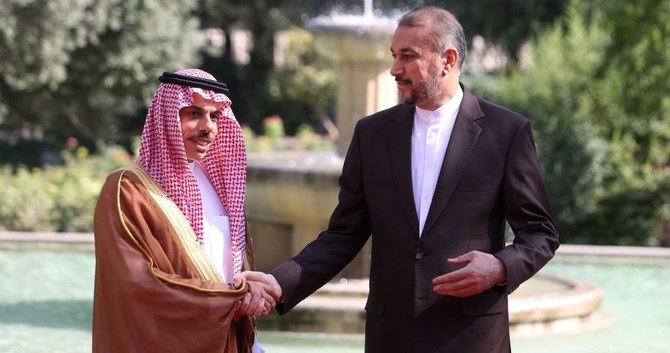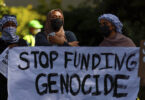Dr. Mohammed Al-Sulami
Saudi Foreign Minister Prince Faisal bin Farhan paid a visit to Tehran on June 17. He met his Iranian counterpart as well as President Ebrahim Raisi. The visit came in response to an invitation by Iranian Foreign Minister Hossein Amir-Abdollahian. There are several observations that could be made about the visit and other matters related to the trajectory of Saudi-Iranian relations and the latest progress on the nuclear talks between Iran and the West.
The first observation is related to the arrival of the Saudi foreign minister at the headquarters of the Iranian Ministry of Foreign Affairs and the red-carpet treatment handed out to him. Despite this hospitality, there was a problem regarding the Saudi flag, which was positioned in the wrong manner. Photos were taken both before and after the flag’s position was changed. The second observation, which is more important in my viewpoint, was the venue of the press conference of the Saudi and Iranian foreign ministers after the deliberations they held at the headquarters of the Ministry of Foreign Affairs. Those attending the press conference were asked to wait in a hall that was named after Qassem Soleimani, with the former Quds Force commander’s picture hanging on the wall. In fact, the Ministry of Foreign Affairs has hosted many press conferences at this venue.
However, the status of Saudi-Iranian relations and the role Soleimani played in the region – which is one of the contentious issues between the two countries – should have attracted the attention of the Iranian side. Therefore, the Saudi officials accompanying the foreign minister refused to hold the press conference at this venue. The conference was moved elsewhere, showing the Iranians’ flexibility. But we also know that the Iranian side did not want to miss this point-scoring opportunity, which is a very negative indication. The third and final observation pertains to the press conference itself. The Iranian foreign minister spoke of what happened during the deliberations that preceded the conference, as well as the importance of normalizing relations between the Kingdom and Iran. When it was the turn of the Saudi foreign minister to speak, he read a written text about what he wanted to raise during his Tehran visit. It was a political message in the first place, which mentioned the most important issues concerning both sides, particularly for the Saudis, such as the building of confidence, noninterference in other countries’ internal affairs and ensuring the region’s security, stability and development. This is in addition to mentioning the importance of boosting ties between the two nations.
In my view, this marks the start of a new phase. It was an unusual press conference that broke long-established traditions. The Saudi foreign minister delivered a clear message from the Saudi side, and this is very important. I hope that Tehran grasps the essence of this message. Yet, finally, the conference lasted nearly 10 minutes and the attending journalists, who were moved from the old, disputed hall to the new one, were not given the chance to pose any questions. Let us now move onto the possible bottlenecks in Saudi Arabia-Iran relations despite the optimism. One would have expected the Iranian side to tread carefully to ensure all protocols were met. However, Iran in haste announced the name of the proposed Saudi ambassador to Tehran and at the same time circulated the name of the proposed Iranian ambassador to Riyadh. This was done without receiving official approval from both sides – a clear violation of diplomatic protocol.
It would be too simplistic to say that this was a mistake on the part of the Iranian side, given the importance of the matter, so a number of important questions arise: Why did the Iranians violate this diplomatic protocol? Is the Iranian leadership becoming overwhelmed by the pace of progress in Tehran’s relations with the Kingdom, particularly the positive messages and gestures from the Saudi side? Are the hard-liners wanting to derail Saudi-Iranian relations, as ties with Riyadh conflict with their anti-Saudi rhetoric? Is there something sinister at play, with attempts to divert the recent optimism over Saudi-Iranian relations? The answer to the last question may be in the affirmative, given that Iranian media outlets recently returned to their negative campaign against the Kingdom. In addition, could it be the case that the Iranian lapse of diplomatic protocol and continuation of media tirades against the Kingdom are linked to the meeting between the E3 (France, Germany and the UK) and Iran in the UAE to discuss the Iranian nuclear program. Or is this Iranian behavior related to the Biden administration’s purported mini or interim nuclear deal offer?
The latter could explain the Iranian behavior. As I have mentioned previously, Iran’s decision to sign a deal with the Kingdom is most likely to be tactical rather than strategic, with it needing economic opportunities to breathe life back into its dying economy and to end its regional and international isolation. On the other hand, the Saudi side is very sincere in its move, which is in harmony with the recent Saudi foreign policy approach. With a possible nuclear deal on the horizon, whatever its length or details, there would be no need for Iran to stick to the deal signed with the Kingdom and abide by diplomatic protocols in its words and deeds. Even though this purported nuclear deal is likely to face opposition in the US Congress, and cause issues for the Democrats leading up to the 2024 presidential election, what is missed are the negative implications for the region. Not addressing the outstanding issues – Iran’s ballistic missiles program, belligerent behavior and financing and training of proxies – would be disastrous and would take the region back to square one. This is a strategic blunder that needs to be avoided. Saudi and Gulf voices need to be listened to rather than dismissed by the US, as happened in the past.







